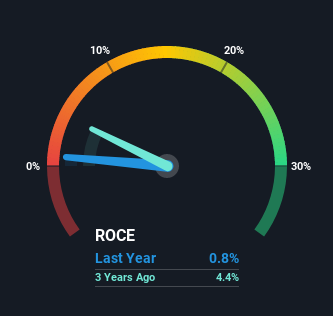- United States
- /
- Renewable Energy
- /
- NasdaqCM:HNRG
Hallador Energy (NASDAQ:HNRG) Is Finding It Tricky To Allocate Its Capital
If we're looking to avoid a business that is in decline, what are the trends that can warn us ahead of time? Businesses in decline often have two underlying trends, firstly, a declining return on capital employed (ROCE) and a declining base of capital employed. This combination can tell you that not only is the company investing less, it's earning less on what it does invest. And from a first read, things don't look too good at Hallador Energy (NASDAQ:HNRG), so let's see why.
Understanding Return On Capital Employed (ROCE)
Just to clarify if you're unsure, ROCE is a metric for evaluating how much pre-tax income (in percentage terms) a company earns on the capital invested in its business. The formula for this calculation on Hallador Energy is:
Return on Capital Employed = Earnings Before Interest and Tax (EBIT) ÷ (Total Assets - Current Liabilities)
0.0084 = US$2.5m ÷ (US$378m - US$77m) (Based on the trailing twelve months to June 2021).
Therefore, Hallador Energy has an ROCE of 0.8%. In absolute terms, that's a low return and it also under-performs the Oil and Gas industry average of 7.1%.
View our latest analysis for Hallador Energy

In the above chart we have measured Hallador Energy's prior ROCE against its prior performance, but the future is arguably more important. If you'd like, you can check out the forecasts from the analysts covering Hallador Energy here for free.
What The Trend Of ROCE Can Tell Us
We are a bit anxious about the trends of ROCE at Hallador Energy. To be more specific, today's ROCE was 8.0% five years ago but has since fallen to 0.8%. What's equally concerning is that the amount of capital deployed in the business has shrunk by 40% over that same period. The fact that both are shrinking is an indication that the business is going through some tough times. Typically businesses that exhibit these characteristics aren't the ones that tend to multiply over the long term, because statistically speaking, they've already gone through the growth phase of their life cycle.
While on the subject, we noticed that the ratio of current liabilities to total assets has risen to 20%, which has impacted the ROCE. If current liabilities hadn't increased as much as they did, the ROCE could actually be even lower. Keep an eye on this ratio, because the business could encounter some new risks if this metric gets too high.
The Key Takeaway
In short, lower returns and decreasing amounts capital employed in the business doesn't fill us with confidence. Investors haven't taken kindly to these developments, since the stock has declined 58% from where it was five years ago. With underlying trends that aren't great in these areas, we'd consider looking elsewhere.
If you want to know some of the risks facing Hallador Energy we've found 3 warning signs (2 are a bit unpleasant!) that you should be aware of before investing here.
If you want to search for solid companies with great earnings, check out this free list of companies with good balance sheets and impressive returns on equity.
Valuation is complex, but we're here to simplify it.
Discover if Hallador Energy might be undervalued or overvalued with our detailed analysis, featuring fair value estimates, potential risks, dividends, insider trades, and its financial condition.
Access Free AnalysisThis article by Simply Wall St is general in nature. We provide commentary based on historical data and analyst forecasts only using an unbiased methodology and our articles are not intended to be financial advice. It does not constitute a recommendation to buy or sell any stock, and does not take account of your objectives, or your financial situation. We aim to bring you long-term focused analysis driven by fundamental data. Note that our analysis may not factor in the latest price-sensitive company announcements or qualitative material. Simply Wall St has no position in any stocks mentioned.
Have feedback on this article? Concerned about the content? Get in touch with us directly. Alternatively, email editorial-team (at) simplywallst.com.
About NasdaqCM:HNRG
Hallador Energy
Through its subsidiaries, engages in the production of steam coal for the electric power generation industry in Indiana.
Excellent balance sheet and good value.
Similar Companies
Market Insights
Community Narratives



